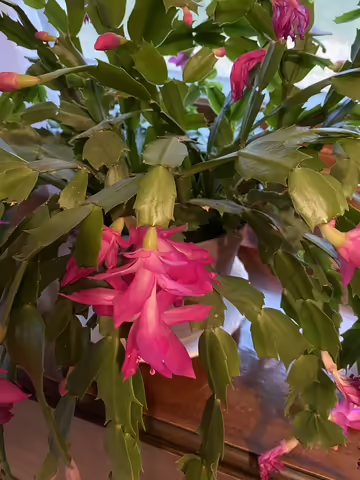While the Poinsettia may be the most popular holiday plant, the holiday cactus is a tradition for many families. These easy to care for cactus generally live a long life. In fact I often hear about holiday cacti being passed down from generation to generation as a family heirloom.
Holiday cacti include the Thanksgiving cactus, Christmas cactus and Easter cactus. So how do you tell the difference between the three holiday cacti? The holiday cacti are easily identified by the stem margins. These cacti don’t have true leaves. Instead they have flattened stem segments.
The most widely grown species is the Thanksgiving cactus, Schlumbergera truncata. The stem margins have two to four sawtoothed projections. Flowers are produced from late November to late December. Thanksgiving cacti are often forced into bloom and sold at Christmas time, often misnamed Christmas cacti.
Christmas cactus, Schlumbergera bridgesii, has scalloped stem margins. Flowers are generally showy from late December through March. he flowers are formed at the tip of the segments.
Easter cactus, Rhipsalidopsis gaertneri, have 4 to 6 rounded teeth along the stem edges and brownish hairs at the leaf tips. Pink or red flowers appear from March through May. Easter cactus may re-bloom.
Holiday cacti blooms are triggered by day length. They bloom when nights are 12 to 15 hours long for 5 to 6 weeks. To initiate flower buds place Thanksgiving and Christmas cacti in a room that doesn’t receive artificial light at night such as a spare bedroom or basement. Cacti can also be placed in an unheated porch until temperatures reach 45 degrees F. Plants should receive bright light during the day with 55 to 65 degrees F. temperatures. Holiday cacti will also bloom if exposed to prolonged cool temperatures between 50 to 55 degrees F.
When plants are in flower, keep in a bright, indirect light. Avoid too much light, overwatering, drafts and heat sources as they will cause the flower buds to drop. While in flower ideal temperatures are 70 degree F during the day and 65 degree F in the evening. Don’t let the soil dry out during flowering.
If plants fail to flower this could be due to interrupted nights or high temperatures.
When the plant is not in flower, water plants thoroughly but let plant dry slightly between waterings. A major disease of holiday cacti is root rot caused by over watering. Water when the top inch of soil is dry to the touch. Fertilize monthly with a complete houseplant fertilizer when the plant is actively growing between April and October. Follow the label directions.) Holiday cacti require a sunny location indoors.
When selecting a new plant, look for sturdy, healthy green foliage, new flower buds and avoid disease or insect damaged plants. I can grow this plant, so I know testify that it is easy to grow and needs minimal care.
